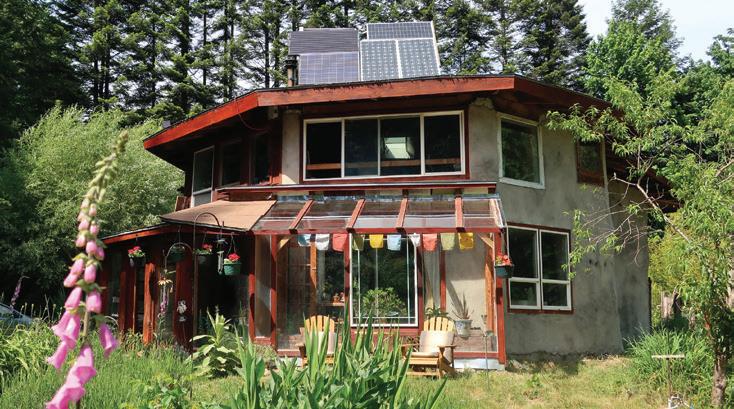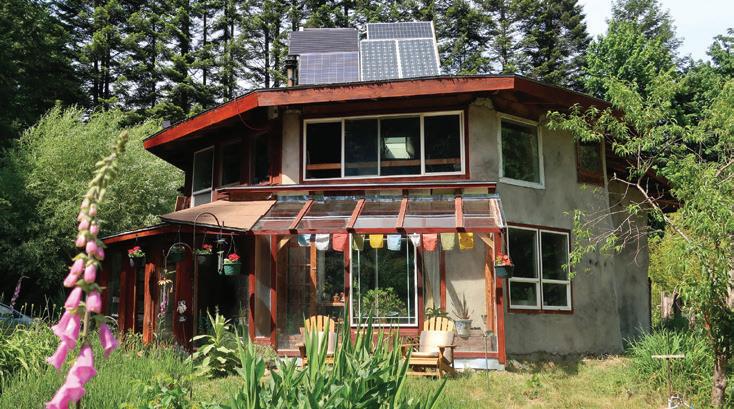
The Homesteader's Holy Grail: Building a High-Efficiency Root Cellar
For the seasoned homesteader, self-sufficiency isn't just a buzzword – it's a way of life. We pour our hearts and souls into our gardens, nurturing crops from seed to harvest. But what happens after the harvest? How do we ensure that the bounty of our labor sustains us throughout the long winter months? The answer, my friends, lies beneath our feet: the root cellar.
Today, we're diving deep into the art and science of building a high-efficiency, naturally ventilated root cellar – a project that, while demanding, offers unparalleled rewards in terms of food preservation, cost savings, and homestead resilience. So, grab your tools, put on your thinking caps, and let's get building!

Why a Root Cellar? More Than Just Food Storage
Before we get into the nuts and bolts of construction, let's reiterate why a root cellar is an invaluable asset for any serious homesteader focused on food preservation and self-sufficiency. Beyond simply storing storage crops, a well-designed root cellar acts as a natural refrigerator, maintaining cool temperatures and high humidity levels ideal for preserving a wide variety of fruits and vegetables. This allows you to enjoy the flavors of your garden long after the growing season has ended, reducing your reliance on store-bought produce and significantly cutting down on your grocery bills. A DIY root cellar also offers a sustainable alternative to energy-intensive refrigerators and freezers, aligning with the principles of sustainable living.
Project Overview: An 8ft x 6ft x 7ft Concrete Block Root Cellar
This guide details the construction of an 8ft x 6ft x 7ft root cellar, a size that provides ample storage for a small to medium-sized homestead. The structure will be built using concrete blocks, chosen for their durability, thermal mass, and affordability. Natural ventilation will be achieved through a carefully designed system, ensuring optimal temperature and humidity control.
Step 1: Planning and Site Preparation
The success of your root cellar hinges on careful planning. Consider the following factors:
- Location: Choose a location that is naturally cool, shaded, and well-drained. A north-facing slope is ideal. Avoid areas prone to flooding or with high water tables.
- Soil Type: Well-draining soil is crucial to prevent moisture buildup. If your soil is heavy clay, consider amending it with sand and organic matter.
- Accessibility: Ensure the root cellar is easily accessible from your garden and home, especially during the winter months.
- Local Codes and Regulations: Check with your local authorities regarding any building codes or permits required for root cellar construction.
Once you've selected your site, clear away any vegetation, rocks, and debris. Excavate the area to a depth of 7 feet, ensuring the walls are plumb and the bottom is level.

Step 2: Laying the Foundation
A solid foundation is paramount for the longevity of your root cellar.
Materials:
- Gravel (3/4" crushed stone): Approximately 4 cubic yards (available at most local quarries or landscaping suppliers)
- Concrete blocks (8" x 8" x 16"): Quantity will vary depending on your layout, typically around 250-300 blocks
- Mortar mix: Sufficient for laying all concrete blocks (available at home improvement stores)
- Rebar (1/2" diameter): Approximately 20 feet (for reinforcing the foundation)
Tools:
- Shovel
- Level
- Tamper
- Concrete mixer (rental or purchase)
- Mortar trowel
- Rebar cutter/bender
Process:
- Pour a 6-inch layer of gravel into the excavated area and compact it thoroughly with a tamper. This will provide drainage and prevent moisture from wicking up into the concrete.
- Mix your mortar according to the manufacturer's instructions.
- Begin laying the first course of concrete blocks, ensuring they are level and square. Use a mortar trowel to apply a generous layer of mortar between each block.
- Insert rebar vertically into the mortar joints every 4 feet for added reinforcement.
- Continue laying subsequent courses of blocks, staggering the joints for increased stability. Use a level to ensure each course is perfectly horizontal.

Step 3: Waterproofing and Insulation
Protecting your root cellar from moisture is crucial for preserving your harvest. Adequate insulation also helps to maintain consistent temperatures.
Materials:
- Waterproof membrane (e.g., bituminous coating or polyethylene sheeting): Sufficient to cover all exterior walls and the roof.
- Rigid foam insulation (2" thick): Sufficient to cover the exterior walls and roof. (available at most home improvement stores)
- Construction adhesive: For adhering insulation to the walls.
Tools:
- Paintbrush or roller (for applying waterproofing)
- Utility knife (for cutting insulation)
Process:
- Apply a thick layer of waterproof membrane to the exterior walls of the root cellar, ensuring complete coverage. Pay particular attention to the joints between the blocks.
- Once the waterproofing has dried, apply rigid foam insulation to the exterior walls using construction adhesive. Ensure the insulation is tightly fitted to prevent gaps.

Step 4: Constructing the Roof
The roof should be strong enough to support the weight of the soil and any potential snow load.
Materials:
- Treated lumber (2" x 8" for rafters, 4" x 4" for support posts): Dimensions will depend on your roof design.
- Plywood (3/4" thick): For sheathing the roof.
- Waterproof membrane (same as used for the walls).
- Soil (for covering the roof): Approximately 2-3 feet of topsoil.
Tools:
- Circular saw
- Drill
- Hammer
- Measuring tape
Process:
- Construct a sturdy roof frame using treated lumber. Ensure the rafters are adequately spaced to support the weight of the soil.
- Sheathe the roof frame with plywood, securely fastening it with screws or nails.
- Apply a layer of waterproof membrane to the plywood sheathing, overlapping the edges to prevent leaks.
- Cover the roof with a thick layer of soil, sloping it slightly to promote drainage.
Step 5: Installing the Ventilation System
A well-designed ventilation system is critical for maintaining optimal temperature and humidity control inside the root cellar. This will help prevent spoilage and extend the shelf life of your storage crops.
System Design:
Our natural ventilation system will utilize two 4-inch diameter PVC pipes:
- Intake Vent: This pipe will be located near the floor of the root cellar, bringing in cool, fresh air from outside. The outside opening should be shielded with mesh to prevent rodents from entering.
- Exhaust Vent: This pipe will be located near the ceiling, allowing warm, moist air to escape. This vent should extend above the roof of the root cellar to promote airflow.
Materials:
- PVC pipe (4" diameter): Sufficient for both intake and exhaust vents.
- PVC fittings (elbows, couplings): As needed to connect the pipes.
- Wire mesh: For shielding the outside openings of the vents.
Process:
- Install the intake vent near the floor of the root cellar, ensuring the outside opening is shielded with wire mesh.
- Install the exhaust vent near the ceiling, extending it above the roof of the root cellar.
- Connect the pipes using PVC fittings, ensuring all joints are watertight.

Step 6: Building the Entrance and Shelving
The entrance should be sturdy and well-insulated to prevent temperature fluctuations. Shelving provides organized storage for your produce.
Materials:
- Treated lumber (for the door frame and door).
- Insulation (for the door).
- Hinges and latch.
- Lumber (for shelving): Choose untreated lumber for food safety.
Tools:
- Saw
- Drill
- Hammer
Process:
- Construct a sturdy door frame using treated lumber.
- Build a well-insulated door that fits snugly within the frame.
- Install hinges and a latch to secure the door.
- Build shelving units using untreated lumber, ensuring they are strong enough to support the weight of your produce.
Step 7: Backfilling and Finishing Touches
Backfill around the root cellar with soil, compacting it firmly to provide insulation and support. Add any desired landscaping features, such as stone steps or a decorative entrance.
Troubleshooting and Potential Challenges
- Moisture Buildup: If you notice excessive moisture inside the root cellar, increase ventilation by opening the vents wider or adding a small fan.
- Temperature Fluctuations: Ensure the door is tightly sealed and the insulation is adequate. Consider adding a layer of straw or hay to the roof for extra insulation during the winter months.
- Pest Control: Regularly inspect the root cellar for signs of rodents or insects. Seal any cracks or openings and consider using natural pest control methods.
The Fruits (and Vegetables!) of Your Labor
Building a root cellar is a significant undertaking, but the rewards are well worth the effort. With a well-built and properly maintained root cellar, you can enjoy fresh, locally grown produce throughout the year, reduce your reliance on store-bought food, and increase your homestead resilience. So, get out there, put your skills to the test, and build yourself a DIY root cellar – your future self (and your stomach) will thank you for it! Remember to incorporate those cellaring techniques for optimal results.